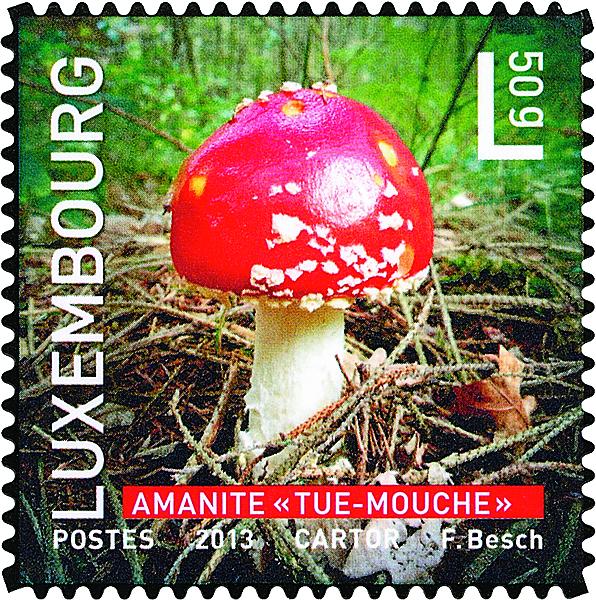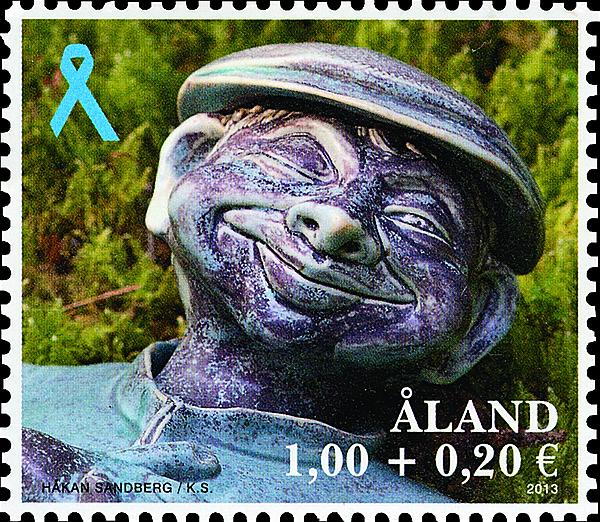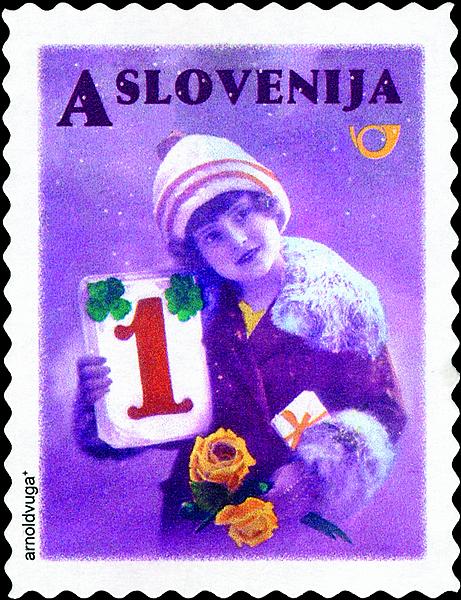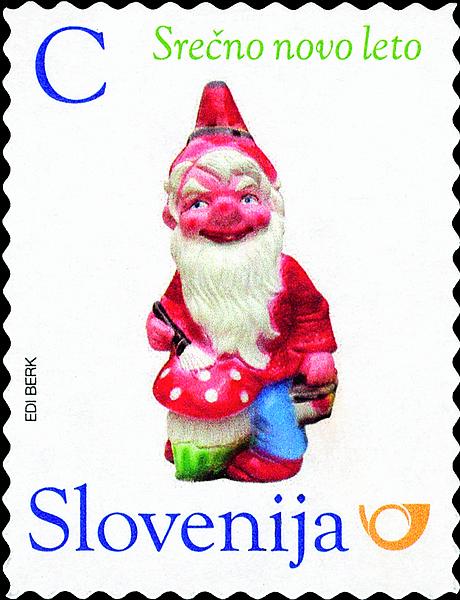World Stamps
Garden gnomes, toadstools on new stamps
A gnome and four-leaf clover represent good luck on a pair of New Year’s Greetings stamps issued by Slovenia on Nov. 22, 2013.
The nondenominated C stamp for use on international letters shows a red-capped garden gnome painting the white dots on a red mushroom, the poisonous Amanita muscaria commonly called fly agaric or simply toadstool.
Figure 1 shows this stamp. According to the new-issue announcement from Slovenia, the toadstool serves as a symbol of long or eternal life in some cultures.
This same announcement describes a gnome as “a legendary creature similar to a goblin but with a much more positive character.”
Gnomes were considered to bring good luck if they were treated well. They also have been associated with fertility and riches and are considered to be guardians of knowledge and wisdom.
The industry of making garden gnome statues to place in your yard or garden began in Germany. The oldest known such gnome, Lampy, was one of 21 that Charles Isham brought with him from Germany to England in 1847.
The website of the Lambert Hall and Gardens in Northamptonshire, England, says: “Sir Charles [Isham] is responsible for the remarkable rockery which is the earliest alpine garden in England, rising like a ruined castle and 24 feet tall. Sir Charles peopled it with miniature figures, the world’s first garden gnomes. The only remaining original is on view in the Hall.”
In 1997, Lampy was insured for £1 million.
Figure 2 pictures Slovenia’s nondenominated A New Year’s Greeting stamp, which pays the domestic letter rate. The design is based on 19th-century New Year’s postcards.
The girl shown on the stamp is holding a tablet with a red “1” for Jan. 1. The tablet is decorated with two four-leaf clovers. The girl also is holding yellow roses and a wrapped present.
Both of these Slovenian stamps are self-adhesive. The Czech Republic’s printing office printed them by offset in sheets of 50 and in booklets of 12. Edi Berk designed the C stamp, and Studio Arnoldvuga designed the A stamp.
Aland
A gnomelike garden sculpture and a blue ribbon symbolize prostate cancer awareness on the semipostal stamp shown in Figure 3. Aland issued this €1+€0.20 stamp Sept. 2 to raise money for the Aland Cancer Society.
Hakan Sandberg, the artist who designed the stamp, is a prostate cancer survivor. In an article in Aland Post’s Frimarken bulletin, Sandberg explained various concepts he had for the design.
He said, “In the end, I realized that I wanted the stamp motif to symbolize me. I’m very interested in gardening and nature, and I feel great joy in sowing a seed, watching it grow and reaping the crop in the autumn. It’s a bit like the human life cycle. Being in nature, all your stress and worries disappear, you tend to become more present, an important factor of my healing process.”
Thus, he decided to use a garden sculpture that he had created. He described this 23-inch sculpture as “a bon vivant who enjoys life on this Earth.”
Although the sculpture usually lies in the Sandbergs’ garden, for the stamp, it was photographed lying in a bed of moss in an area of the forest where Sandberg and his wife pick mushrooms.
Joh. Enschede of the Netherlands printed 170,000 examples of this Aland semipostal in sheets of 30 (divided into two panes of 15).
This is Aland’s second semipostal stamp. The first, issued Oct. 1, 2012, promotes breast cancer awareness (Scott B1).
Luxembourg
Mushrooms, a popular stamp subject, appear on countless stamps each year, but new stamps from Luxembourg focus more on the photography than the fungi.
The five nondenominated stamps for domestic letters weighing up to 50 grams were issued Dec. 3 in a booklet of 10.
Francois Besch, a pioneer in smartphone photography, took the photographs that appear on the stamps for an exhibition at Galerie Clairefontaine in Luxembourg. Figure 4 shows the stamp featuring Amanita muscaria.
The other stamps picture common puffball (Lycoperdon perlatum), orange peel fungus (Aleuria aurantia), turkey tail mushroom (Trametes versicolor) and bay bolete (Boletus badius).
Besch used the Hipstamatic application, or app, while taking the snapshots. Through simulated filters, lens and flashes, the app helps to recreate the look of photographs taken by an old film camera.
According to the hipstography website, http://hipstography.com, these Mushroom stamps are the first to feature Hipstamatic photographs.
Cartor of Meauce, France, printed the stamps by offset.
MORE RELATED ARTICLES
Headlines
-
World Stamps
Oct 8, 2024, 12 PMPostcrossing meetup Oct. 9 at U.N. headquarters
-
Postal Updates
Oct 7, 2024, 5 PMUSPS plans to raise postal rates five times in next three years
-
US Stamps
Oct 7, 2024, 3 PMMcMurtrie dismissed as APS education director following Sept. 21 arrest
-
US Stamps
Oct 7, 2024, 12 PMVasiliauskas named president of Mystic Stamp Co.









